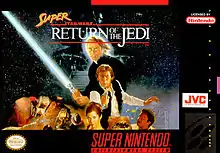Super Star Wars: Return of the Jedi
Super Star Wars: Return of the Jedi is a run and gun released for the Super Nintendo Entertainment System in North America on June 22, 1994, Europe on March 30, 1995 and in Japan on June 23, 1995. It is the third and final game in the Super Star Wars trilogy and is based on the 1983 film Return of the Jedi. There is also a simplified version for the Game Boy and Game Gear portable systems. The game was re-released on the Wii Virtual Console in North America on September 7, 2009 and in PAL regions on October 16, 2009, alongside the other games in the Super Star Wars series.[2]
| Super Star Wars: Return of the Jedi | |
|---|---|
 | |
| Developer(s) | LucasArts (SNES) Sculptured Software (SNES) Realtime Associates (GB/GG) |
| Publisher(s) | JVC (SNES) THQ[lower-alpha 1](GB/GG/NA SNES Re-release) LucasArts (Virtual Console) |
| Director(s) | Kalani Streicher |
| Producer(s) | Kalani Streicher |
| Designer(s) | Kalani Streicher |
| Programmer(s) | Peter Ward |
| Composer(s) | Paul Webb[1] |
| Platform(s) | Super NES, Game Boy, Game Gear |
| Release | Super NESGame GearGame BoyWii Virtual Console |
| Genre(s) | Run and gun |
| Mode(s) | Single player |
Plot and gameplay
Super Star Wars: Return of the Jedi follows closely the standard set by the previous two Super Star Wars games, with the return of selectable characters (on specific levels), multiple playable characters and Mode 7 quasi-3D vehicle sequences. The controls are identical to the second game, and this installment also includes its predecessor's password save option. It loosely follows the plot of Return of the Jedi, with some added scenes, such as Luke Skywalker having to fight through the Death Star to get to Emperor Palpatine. In addition to the standard Luke Skywalker, Han Solo, and Chewbacca, Princess Leia and Wicket appear as playable characters.[3]
Bosses include Jabba the Hutt, the Rancor beast, Darth Vader and Emperor Palpatine. Vehicle sequences include the Endor speeder bike chase, and a cruise in the Millennium Falcon. Luke Skywalker no longer has nine Force powers to work with but five and it is easier for him to "recharge" his abilities. He also cannot use any variation of the blaster in this game. Princess Leia is unique in that her appearance and playstyle changes in accordance with the plot. She uses a staff as the bounty hunter Boushh when approaching Jabba's palace, fights with a broken chain as Jabba's escaped slave on his sail barge, and wields a blaster when fighting on Endor as a Rebel leader.
Release
In 1996 THQ announced that they would re-release Super Star Wars: The Empire Strikes Back and Super Star Wars: Return of the Jedi in February 1997 in order to coincide with the "Special Edition" of those films appearing in theaters.[4] The re-release is identical to the original version.[5]
Reception
| Aggregator | Score |
|---|---|
| GameRankings | 82.80%(SNES)[6] |
On release, Scary Larry of GamePro gave the Super NES version a mostly negative review. Though he praised the musical score, he criticized the game for frustrating controls, overly easy bosses, and particularly the level designs, which he said are repetitious and mostly feel like retreads of level designs from the two previous games in the series.[7] In contrast, Electronic Gaming Monthly gave it an 8 out of 10, praising it for the "excellent" graphics and the need to move carefully through the levels.[8] Famicom Tsūshin scored it a 23 out of 40.[9]
GamePro's Coach Kyle found some flaws in the Game Boy version, such as the rudimentary backgrounds, but rated it "one of the year's most fun and challenging handheld games", particularly due to the diverse gameplay offered by the five playable characters.[3] Quick-Draw McGraw gave the Game Gear similar praise in the same magazine, and said the graphics are nearly as good as the SNES version's.[10]
Super Return of the Jedi was awarded Best Movie-to-Game of 1994 by Electronic Gaming Monthly.[11] EGM and GamePro both named it Best Game Gear Game of 1995.[12][13] IGN placed the game as number 26 on their Top 100 SNES Games of All Time.[14]
References
- "Composer information for Super Star Wars: Return of the Jedi". SNES Music. Retrieved 2012-07-05.
- "From Faraway Galaxies to the Family Room, Start Fall on a Fun-Filled Foot". Nintendo of America. 2009-09-07. Archived from the original on 2017-08-22. Retrieved 2009-12-14.
- "ProReview: Super Return of the Jedi". GamePro. No. 87. IDG. December 1995. p. 142.
- "16-Bit's Final Hurrah" (PDF). Electronic Gaming Monthly. No. 88. Ziff Davis. November 1996. p. 22.
- "The Super Star Wars Trilogy Soars". GamePro. No. 103. IDG. April 1997. p. 92.
- "Super Star Wars: Return of the Jedi aggregated score".
- "ProReview: Super Return of the Jedi" (PDF). GamePro. No. 75. IDG. December 1994. pp. 122–123.
- "Review Crew: Super Return of the Jedi". Electronic Gaming Monthly. No. 63. Sendai Publishing. October 1994. p. 32.
- NEW GAMES CROSS REVIEW: スーパー・スターウォーズ/ジェダイの復讐. Weekly Famicom Tsūshin. No.341. Pg.30. 30 June 1995.
- "ProReview: Super Return of the Jedi". GamePro. No. 87. IDG. December 1995. p. 144.
- "Electronic Gaming Monthly's Buyer's Guide". 1995. Cite journal requires
|journal=(help) - "Electronic Gaming Monthly's Buyer's Guide". 1996. Cite journal requires
|journal=(help) - "Editor's Choice Awards 1995". GamePro. No. 89. IDG. February 1996. p. 26.
- Top 100 SNES Games of All Time - IGN, retrieved 2021-01-26
- Released under the Black Pearl Software brand name on Game Boy and Game Gear
External links
- Super Star Wars: Return of the Jedi at IMDb
- Super Star Wars: Return of the Jedi on Wookieepedia, a Star Wars wiki
- Super Star Wars: Return of the Jedi at MobyGames